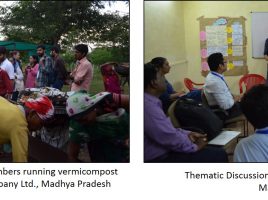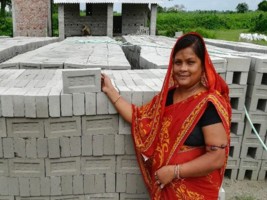How are Food and the Environment related?
Are we killing the environment or is it killing us? When we look at what we eat and how we grow it, we find extensive evidence for damage both to our food (from pollution and soil depletion) and to our environment (from the toxicity of growing foods industrially).
How what we eat and grow impacts our planet?
It is well known that the impact of our food system on the natural world is complex. Many factors including farming method, where food is grown, what pesticides and fertilisers are used, what is fed to our livestock, and so on, contribute to the environmental impact of the food we buy and eat. For example, in the United States of America, there is demand for cheap food, so their agricultural policy for the past 30 years has focused on providing large amounts of inexpensive calories. Two of the cheapest sources of calories are corn and soy, which the federal government has long subsidized and which make up a large percentage of their caloric intake today (often in the form of high fructose corn syrup or soybean oil). Corn is also a large part of the diet of the animals that are eaten. Corn and soy are prized because they can be efficiently grown on vast farms. However, growing just one crop consistently (a monoculture) depletes the soil and forces farmers to use greater amounts of pesticides and fertilizers thus making it a vicious cycle.
Ways in which food grown can affect nature
- One of the primary environmental concerns with modern agriculture has to do with the chemicals put on crops and what happens when those crops end up in the watershed. Pesticides and other chemicals are often used to produce more crops, and these pesticides don’t just fall on the crops and stay there. They are transported via wind and water and affect the surrounding ecosystems. Fertilizers are also used in agriculture and while they are a nutrient for some plants they end up in streams and lakes in amounts higher than would occur naturally. For example, currently, the dead zone in the Gulf of Mexico, where no fish or other animals can live, has grown to 8,543 square miles, the size of New Jersey. This is due to chemicals in the Mississippi River, particularly fertilizers, as it flows into the Gulf
- Agricultural practices are also known to take up a lot of land. Due to the finite amount of land on the planet, it poses as an environmental threat as forests, grasslands, and other ecosystems are converted into farmland. When we clear land for agriculture, the plant species that are native to the region are replaced with plants that aren’t as effective in retaining the soil and its nutrients. Thus, the soil quality degrades over time. Besides this, it also causes flooding during heavy rainfall as the soil is not bound to the roots.
- Another problem has to do with the amount of water some crops require. Agriculture consumes extensive amounts of water. It takes a tremendous amount of freshwater to grow crops and feed for other animals that we consume. Sometimes we use too much water and sometimes we try to grow plants in environments that aren’t suited for them, using more water than we would if we had grown them in an environment more like what that crop would typically be found in. This may also be driven by the state. For example, in India, it has been observed that even though Minimum Support Prices (MSPs)[1] are currently announced for 23 crops, the most effective price support is for sugarcane, wheat and rice. This creates highly skewed incentive structures in favour of these water intensive crops. These thirsty crops are thus draining the country.
Therefore, the global food system, with different agricultural practices from choice of crops grown, area of land used for it, manufacture of fertilizers to food storage and packaging, is responsible for up to one-third of all human-caused greenhouse-gas emissions, according to the latest figures from the Consultative Group on International Agricultural Research (CGIAR), a partnership of 15 research centres around the world. Reducing agriculture’s carbon footprint is thus central to limiting environmental degradation and effects of climate change.
How does the environment impact our food?
Environmental Degradation and Climate Change
Environmental degradation caused and aggravated by pollution, overexploitation of natural resources etc. has been leading to severe, pervasive and irreversible changes for people, assets, economies and ecosystems around the world. Owing to the irresponsible actions of humans, there has been a rise in global temperature leading to climate change. Global sea levels are rising at an average rate of 3.4 millimetres per year, the Arctic sea ice volume reached record low in 2018, Antarctic ice sheet melting rate has accelerated threefold over the last five years, and exposure to natural hazards doubled in the last 40 years, affecting an increasing number of people.
Impacts of Climate Change on Food Security across the World
Food security among others has been identified as one major and immediate implication of climate change. It has been estimated that by 2050, climate change could cause irrigated wheat yields in developing countries to drop by 13%, and irrigated rice could fall by 15%. In Africa, maize yields could drop by 10–20% over the same time frame. So, it is no secret that climate change-induced extreme weather conditions, temperature increase and sustained changes in climatic patterns have cast a shadow on the productivity of Indian agriculture thus leading to food insecurity.
Indian Scenario
India is one of the most vulnerable countries in the world when it comes to climate change. According to a report of the India Meteorological Department (IMD) in 2013, 18 states and two Union Territories have been observing a significant warming trend. According to estimates, India could witness a temperature rise of over 4°C by the last quarter of the century. The Intergovernmental Panel on Climate Change’s (IPCC’s) assessment report in 2014 says that both rice and wheat could see drops in yield by 7-10 per cent and in maize by up to 50 per cent by 2030. According to a study by the Agricultural Economics Research Review published in 2014, rice and wheat yields could witness declines of over 15 and 20 per cent respectively by 2100. The need for adaptation to climatic exigencies has been starkly evident over the years.
Recent studies reveal productivity losses of 4-6 per cent for rice; 6 per cent for wheat; 18 per cent for maize; 2.5 per cent for sorghum; 2 per cent for mustard; and, 2.5 per cent for potato in the last two decades. This decline is only expected to continue. According to a report by the Parliamentary Standing Committee on Agriculture, losses due to climate change are to the tune of 4-9 per cent of the agricultural economy each year, which is an overall GDP loss of 1.5 per cent.
National Innovations in Climate Resilient Agriculture (NICRA), is India’s first but little known central government programme launched in 2010-11 to address the risk of climate change. The programme, run under the aegis of the Indian Council of Agricultural Research, covers 151 villages that are vulnerable to extreme weather. The objective is to provide site-specific technological demonstrations to enhance the adaptive capacity of farmers in “climatically vulnerable districts” of the country. According to officials from NICRA, about 24 interventions are being implemented to boost natural resource management, crop production, livestock and fisheries potential and farmers’ financial safety nets. Though, this programme has its implementation challenges even after eight years of it being launched, it was necessary for the government to step-in and attempt to take charge of the havoc climate change was playing with agriculture.
Way Forward
There is thus a direct link between climate change, land-water management and food security more so in developing countries where climate change compounded with poverty has exacerbated the impacts. There is need for policy makers, communities and aid providers to incorporate evidence based technologies in food systems and knowledge.
Policy makers must ensure that mitigation and adaptation measures must be effective, affordable and appropriate for environmental sustainability and development. Most studies conducted advocate for the integration of conventional agro-science based systems with traditional agricultural knowledge in order to mitigate the severity of climate change and its impact on food security and livelihoods sustainability. To adapt to climate change, we need crops that have greater resilience and don’t need a lot of scarce natural resources. For example, millets can adapt to temperature changes, moisture-regimes and input conditions. According to the Food and Agriculture Organization (FAO) millets should be promoted as they increase soil fertility, consume less water and have a high nutritional value. Millet farmers do not burden the state, demanding irrigation or power, and that makes them the ‘Future Smart Food’.
Therefore, there need to be some big changes in the way the food system is governed. Departments in charge of health, agriculture, social security, the environment, trade and so on need to work together to meet many different goals, rather than pursuing different agendas. We need to be bold and creative, and truly work together to rethink food altogether. We should value its producers, and help them do things better for the natural world; we should value the food, and be mindful of where it comes from and what it does to our bodies; and we should value our food culture, sharing good food with the people around us.
Stella George
sgeorge@devalt.org
The views expressed in the article are those of the author’s and not necessarily those of Development Alternatives.
[1] Minimum Support Price is the price at which government purchases crops from the farmers, irrespective of the market price of the crops. It is an important part of India’s agricultural price policy which helps to incentivize the framers attempting to ensure adequate food grains production in the country.






Leave a Reply